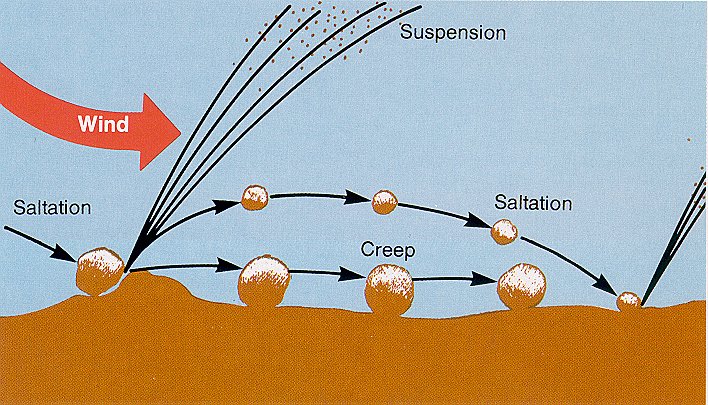where does wind action occur most?
Wind action are prevalent in the arid and semiarid environments, but they also occur in coastal regions. Arid and semiarid lands are regions of very low precipitation, high evaporation, wide temperature ranges, high wind speed and sparse vegetation cover. The lands have wide areas of sandstone and crystalline rock outcrops, called harmada desert. They also have tracts covered with pebbles and large rock fragments referred to as reg desert, and areas of abundant supply of fine to medium size dry and loose sand known as erg desert. All these are environmental conducive to aeolian denudation.
Some arid features are, however processes other than winds. Some of these processes are dew weathering, block disintegration and fluvial erosion and deposition. Indeed, the wind is more potent as an agent of transportation and deposition than that of erosion in arid lands.
Dynamics of wind action
wind erosion
As the wind blows, it comes in contact with the earth's surface and wears it down through three basic processes which are, deflation, abrasion and attrition.
where there are fine, loose and dry sediments, or where the parent rocks are fault-shattered, the wind picks up the fine sediments, or detaches and blows away rock particles from the fault-shattered ares. This wind action is known as defation.
The particle deflated are further used as tools by the wind to wear and expose weaker rock surfaces which they hit in a sand blast action. This wearing down action is known as wind abrasion. Abrasion is strongest within some two metres of the earth surface where the largest quantities of sand are moved by wind.
The particles hit against one another and against standing rocks, and wear themselves down into smaller pieces carried by the wind. This process is referred to as wind attrition.
Wind transport
The rock particles thus eroded by the wind are carried by it in three forms, suspension, saltation, and surface creep.

Credit
The finest particles, usually clay and silt materials, are carried by the wind in suspension as dust. This is the dust that settles on our furniture, clothes, books and other things especially during the dry, harmattan season.
Larger particles are carried at very low level within 10-15cm from the surface, by saltation in a similar fashion as running water does.
Larger sand grains, which are too large either remain suspended or to jump in saltation are pushed windward and downslope both by the wind itself and by the constant impact of the saltatin sand grains. This process is called rolling or surface creep.
Wind deposition
The particles being carried by the wind are deposited:
Where the wind hits obstacles like trees or rock protrusions.
when the wind becomes weak and can no longer hold the materials in buoyancy.
when the materials are physically washed down by rainfall.
Various landforms result from these actions of wind erosion, transportation and deposition.
Reference
https://www.opengeography.org/ch-7-weathering-erosion-and-deposition.html
http://milford.nserl.purdue.edu/weppdocs/overview/wndersn.html

You received a 80.0% upvote since you are a member of geopolis and wrote in the category of "geopolis".
To read more about us and what we do, click here.